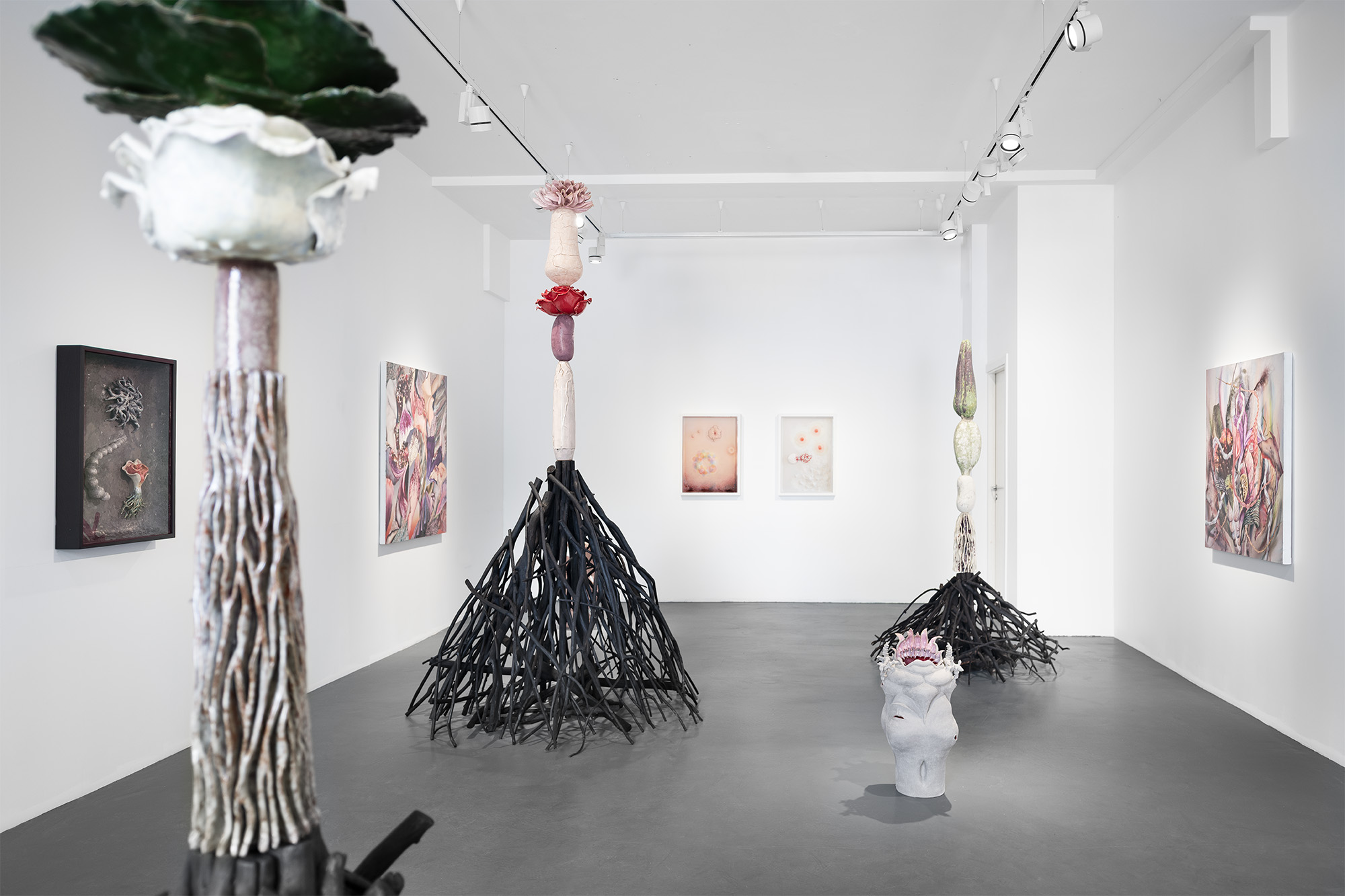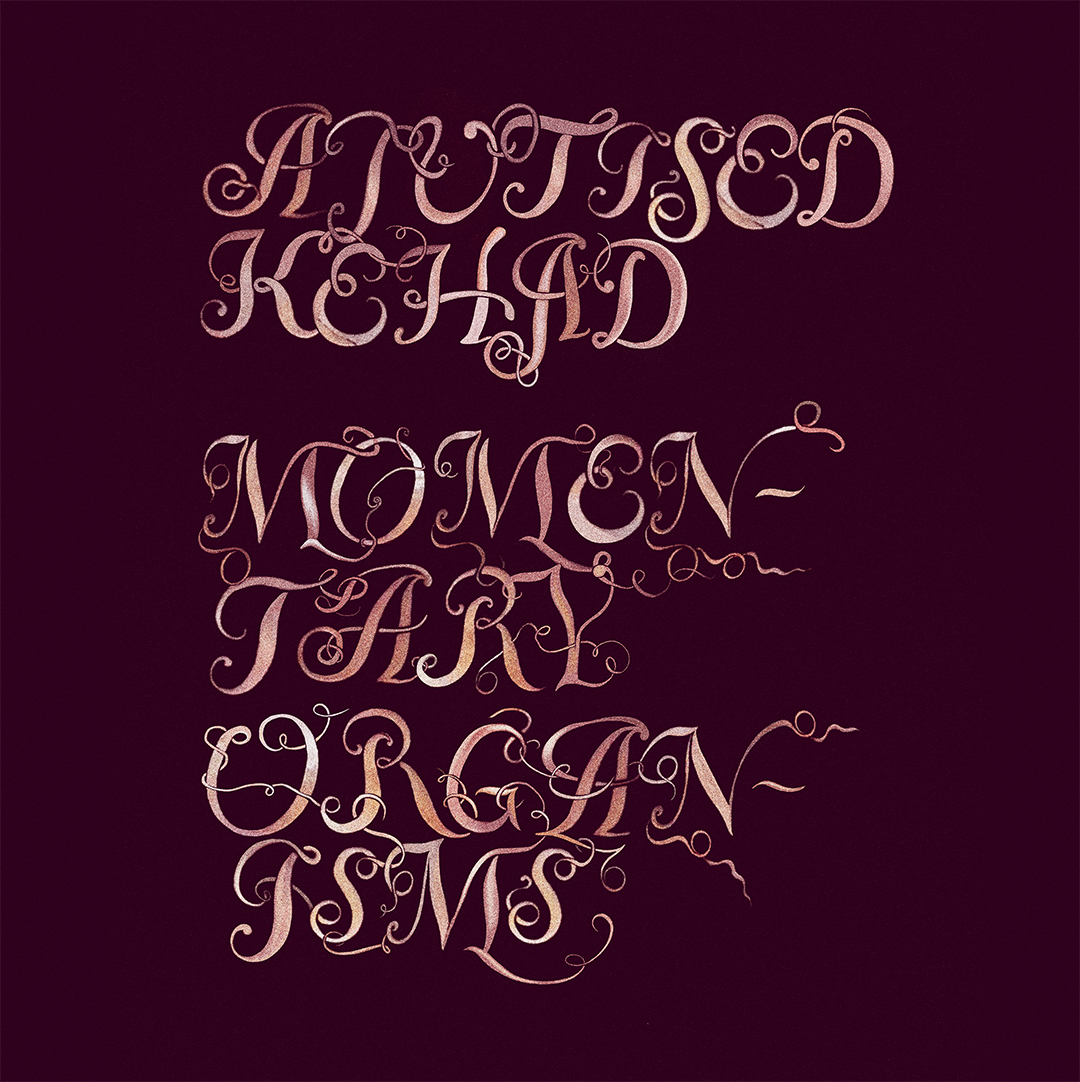Momentary Organisms
Paweł Matyszewski
Curated by Šelda Puķīte
15.8.2025 — 27.9.2025
OPENING
15 August at 18.00
Paweł Matyszewski’s created worlds are exuberant landscapes full of pulsating organisms that are as inviting and mesmerising as they are disturbing and strange. Full of romantic notions and political emergencies, beauty and sensuality, as well as decline, his patchwork-like abstractions can be seen as nature in constant flux, processing all living tissue, composting bodies, knowledge and emotions into new, marvellous substances. Paweł’s approach can be described as Frankensteinian, as he constantly attempts to create images of new organisms by dissecting and restitching together different plant and human body parts. Everything in his works is positioned in a fusion of shared relationships that highlights the interconnectedness of species.
The exhibition Momentary Organisms represents the omnipresent notion of transformation and fragility inherent in every living organism as it undergoes the cycles of life and death. The same can be said about lands, which, due to natural causes or human activity, are constantly changing. This fragile state also stems from a sense of present geopolitical instability that stimulates speculations about worrisome futures. Yet it is also a love letter to an artist’s garden in the village of Łękobudy, located in the northeastern part of Poland, which for this project has become mobile, travelling from one borderland in Poland to another in Estonia.
The exhibition is a reflection of Paweł’s creative oeuvre and his love for plants and gardening, as well as a contemplation on environmental and political change. It offers a representation of biodiversity, infused with speculative visions about potential humanless worlds. Its most lavish components are his paintings from the cycles Biological Compositions and Patches – juxtapositions of images of different botanical species and the presence of human tissue, revealed through the forms of the fleshy, mildly erotic corporality of a new species.
The new ceramic works titled Fusion explore the same worlds in three-dimensional forms. They incorporate impressions collected during the artist’s trips to Southeast Asia while also introducing new materialities. The small-scale sculptures feature corporeal elements that merge into sensual overgrowth on the verge of collapse. In some of the works, the artist builds up the mounting tension by playing with the dichotomy of exterior and interior. Their surfaces are more muted, like a sandy skin that protects the body. In contrast, the insides are lush and fleshy, glazed forms resembling carnivorous plant-like creatures. The bridge between the two is found in the open mouth and lip-like elements, formed on the surface of the sculptures, yet tinged with red that hints at the vibrant, bright interior hidden within.
The cycle of reliefs entitled Collections are the butterflies of the exhibition, case studies locked behind glass. These curiosity cabinets can be viewed as collections of knowledge, each piece touching upon a different area – corporeality, body modification, eroticism, botany, destruction, abuse and others. The works present a subtle message, a trace left on the surface, a bump, a crack, mixed with different recognisable corporal elements.
At the centre of this fleshy, vibrant world, several large sectional pieces made out of clay, chalk, and charred branches and roots have arisen. They resemble both trees that have been torn out of the ground and totems that hold the sacred fruits of life for those in need. Their clay bodies store edible and utilitarian plants, including root vegetables, legumes, leafy greens and fruits, as well as ornamental species such as rose buds. One can also spot in the mix shapes that resemble bullets, which, just like burned wooden branches, remind one of possible war-related threats. The work presents a speculative time capsule, a foldable carry-on garden to take with you in case you need to start again in a foreign land.
Pawełs’ Momentary Organisms is a floating garden, an inner composter, a laboratory and a cabinet of curiosities that blends and processes all the ideas and organisms in one. It is a momentary organism that inhabits space like a forest or a jungle, camouflaging and exposing its multidimensional, evolving yet also deteriorating body. Presented as one interconnected organism comprising various hybrid and juxtaposed beings, the exhibition explores both the beauty and fragility of an ever-changing world.
Momentary Organisms is organised in collaboration with Le Guern Gallery in Warsaw, which focuses on exhibiting the work of emerging artists from the Polish and international art scene. Presenting the work of some of the most challenging contemporary artists, as well as supporting young local artists, the gallery shapes its profile with reference to the current visual manifestations.
The exhibition is part of our this year’s programme Thrifters and Transformers.
Paweł Matyszewski (b. 1984 in Bialystok) is a Polish artist and gardener. He received his MA degree with honours from the Faculty of Painting in the studio of Professor Piotr C. Kowalski at the Academy of Fine Arts in Poznań in 2009. In 2021, he obtained his doctoral degree in Interdisciplinary Doctoral Studies at the Faculty of Multimedia Communication in the University of Arts in Poznań, under the supervision of Dominik Lejman, PhD. He has exhibited his solo projects at Arsenal Gallery in Bialystok, Biala Gallery in Lublin, Piekary Gallery in Poznan and the Baltic Gallery of Contemporary Art in Ustka. His work has also been exhibited in numerous group shows in Poland and abroad, including at Zacheta – National Gallery of Art in Warsaw, BWA Gallery in Bielsko-Biała, the Museum of Contemporary Art in Minsk, Belarus, and many others. He has received numerous awards and fellowships, including the Young Poland Fellowship of the Polish Ministry of Culture and National Heritage and artistic awards at the Bielska Jesien Painting Biennale and the Fish Eye Biennale.
His works are also part of collections at Arsenal Gallery, Białystok; City Gallery Arsenal, Poznan; BWA Bielska Gallery, Bielsko-Biała; the Masovia Centre of Contemporary Art “Elektrownia”, Radom; the National Museum in Gdańsk; the Baltic Gallery of Contemporary Art, Slupsk; The Gallery of Art in Legnica; and Contemporary Gallery Zrenjanin, Serbia.
Šelda Puķīte (b. 1986) is a Latvian curator, writer and researcher based in Estonia. Her formal education includes a Master’s and a Bachelor’s degree from the Department of Art History and Theory at the Art Academy of Latvia. She has worked on several international exhibitions, curated stands for art fairs including Liste Art Fair Basel, viennacontemporary and Art Brussels, published art albums, created catalogues for contemporary art festivals Survival Kit and Riga Photography Biennial, as well as written several essays for Baltic culture publications. Her most recent curated exhibitions include Eike Eplik’s solo exhibition In Times When Everything Else Seems More Important (2025) at Kogo Gallery, Tartu, Silver Girls. Retouched History of Baltic Photography (2025) together with Agnė Narušytė and Indrek Grigor at National Gallery of Art, Vilnius, and White Dwarfs and All Those Beautiful Nebulas (2024) at Kim? Contemporary Art Centre, Riga. Since 2020, she works at Kogo Gallery as an international project manager and exhibition programme curator.
TEAM
Artist: Paweł Matyszewski
Curator: Šelda Puķīte
Le Guerni Gallery team: Agata Smoczyńska-Le Guern, Olga Guzik-Podlewska
Production: Stella Mõttus
Communication: Karin Kahre, Stella Mõttus, Tähe Leen Metsoja
Installation: Siim Asmer
Photos: Marju Eelma (views), Nele Tammeaid (opening)
Text: Šelda Puķīte
Graphic design: Aleksandra Samulenkova
Translation and editing: Refiner Translations
FUNDING
The exhibition is funded by the Cultural Endowment of Estonia, the City of Tartu, Ministry of Culture and National Heritage of the Republic of Poland and Adam Mickiewicz Institute


Press and Publications
.Arterritory, interview with the artist
.Saliva Live, exhibition views
.Echo Gone Wrong, exhibition views
.Estonian Public Broadcasting, TV interview with the artist and curator + photos from the opening (EN)
.Estonian Public Broadcasting, radio interview with the artist and curator (EN + EE)
.Estonian Public Broadcasting, online news (EN)




 In Times When Everything Else Seems More Important
In Times When Everything Else Seems More Important